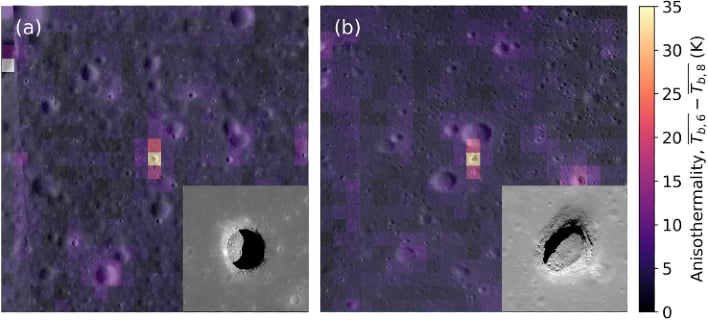NASA Discovers Moon Pits Where Humans Could Live Comfortably In The Shade
NASA's Artemis program is slated to put the first human boots back onto the surface of the Moon in decades. The space agency is not only wanting to explore the lunar surface, however. It plans on building a space base on the Moon that will serve as a pit stop of sorts for future missions to Mars and beyond as well. So, these pits could serve as thermally stable sites for lunar exploration in comparison to the Moon's surface, which can heat up to 260 F (about 127 C) during the day and minus 280 F (about minus 173 C) at night.
Pits and caves on the Moon are not something new. They were first discovered in 2009, and have since been looked at as being used as possible shelter. The pits and caves would not only serve as safe havens from the extreme temperatures on the surface, but also provide protection from the cosmic rays, solar radiation and micrometeorites.
Tyler Horvath, a doctoral student in planetary science at the University of California, Los Angeles, says that around 16 of the more than 200 pits are more than likely collapsed lava tubes. These types of tubes are also found here on Earth, and form when molten lava flows beneath a field of cooled lava or a crust forms over a river of lava. This leads to a "long, hollow tunnel." If the ceiling of one of these solidified lava tubes collapses, it opens a pit that can provide an entry way into the rest of the cave-like tube.
"Lunar pits are a fascinating feature on the lunar surface," remarked LRO Project Scientist Noah Petro of NASA's Goddard Space Flight Center in Greenbelt, Maryland. "Knowing that they can create a stable thermal environment helps us paint a picture of these unique lunar features and the prospect of one day exploring them."
The new data has scientists thinking back to the early days here on Earth, when humans lived in caves. "Humans evolved in caves, and to caves we might return when we live on the Moon," stated David Paige, a co-author of the paper recently published in the journal Geophysical Research Letters.
The data that was used was captured by the Diviner Lunar Radiometer Experiment, a thermal camera aboard LRO. Horvath processed the data from Diviner to understand if the temperatures within the pits differed from those on the surface. The results showed that temperatures in the permanently shadowed areas of the pits vary only slightly throughout the lunar day. The research suggests that if a cave extends from the bottom of the pit, it would also have the relatively comfortable temperature of around 63 F (17 C).
The new findings could prove very useful as NASA and other space agencies ponder long term explorations on the lunar surface. A day on the Moon lasts around 15 Earth days, with the surface constantly being struck with sunlight that creates temperatures hot enough to boil water. Throw in the fact that the nights last around 15 Earth days with extreme colds, and taking refuge in one of these pits seems like a pretty good idea.
Top Image Credit: NASA



